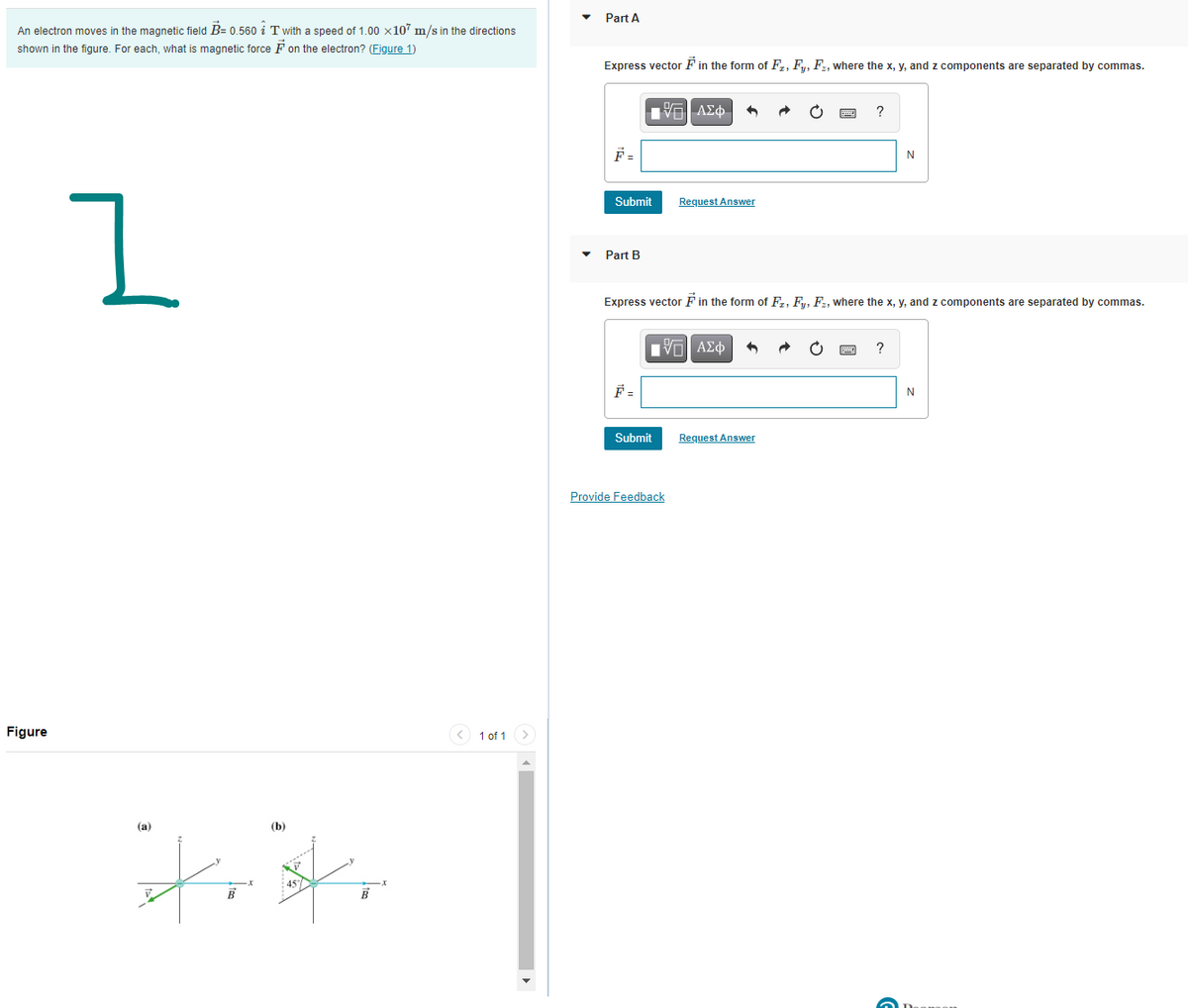Part A An electron moves in the magnetic field B= 0.560 i T with a speed of 1.00 x10' m/s in the directions shown in the figure. For each, what is magnetic force F on the electron? (Figure 1) Express vector F in the form of F,, Fy, F, where the x, y, and z components are separated by commas. ν ΑΣφ - F = N Submit Request Answer Part B Express vector F in the form of E, F. F, where the x, y, and z components are separated by commas. Πνα ΑΣφ ? F = N Submit Request Answer Provide Feedback Figure < 1 of 1> (a) (b) 457
Part A An electron moves in the magnetic field B= 0.560 i T with a speed of 1.00 x10' m/s in the directions shown in the figure. For each, what is magnetic force F on the electron? (Figure 1) Express vector F in the form of F,, Fy, F, where the x, y, and z components are separated by commas. ν ΑΣφ - F = N Submit Request Answer Part B Express vector F in the form of E, F. F, where the x, y, and z components are separated by commas. Πνα ΑΣφ ? F = N Submit Request Answer Provide Feedback Figure < 1 of 1> (a) (b) 457
Principles of Physics: A Calculus-Based Text
5th Edition
ISBN:9781133104261
Author:Raymond A. Serway, John W. Jewett
Publisher:Raymond A. Serway, John W. Jewett
Chapter22: Magnetic Forces And Magnetic Fields
Section: Chapter Questions
Problem 63P
Related questions
Question
Please if you can answer in a way Mastering Physics recognizes. Thank you!

Transcribed Image Text:Part A
An electron moves in the magnetic field B= 0.560 i T with a speed of 1.00 x107 m/s in the directions
shown in the figure. For each, what is magnetic force F on the electron? (Figure 1)
Express vector F in the form of F, Fy, F2, where the x, y, and z components are separated by commas.
.V ΛΣφ.
?
F =
Submit
Request Answer
Part B
Express vector F in the form of Fr, Fy, F, where the x, y, and z components are separated by commas.
Πνα ΑΣφ
F =
N
Submit
Request Answer
Provide Feedback
Figure
< 1 of 1
(a)
(b)
457
B
Expert Solution
This question has been solved!
Explore an expertly crafted, step-by-step solution for a thorough understanding of key concepts.
Step by step
Solved in 2 steps with 1 images

Knowledge Booster
Learn more about
Need a deep-dive on the concept behind this application? Look no further. Learn more about this topic, physics and related others by exploring similar questions and additional content below.Recommended textbooks for you

Principles of Physics: A Calculus-Based Text
Physics
ISBN:
9781133104261
Author:
Raymond A. Serway, John W. Jewett
Publisher:
Cengage Learning

College Physics
Physics
ISBN:
9781285737027
Author:
Raymond A. Serway, Chris Vuille
Publisher:
Cengage Learning

College Physics
Physics
ISBN:
9781305952300
Author:
Raymond A. Serway, Chris Vuille
Publisher:
Cengage Learning

Principles of Physics: A Calculus-Based Text
Physics
ISBN:
9781133104261
Author:
Raymond A. Serway, John W. Jewett
Publisher:
Cengage Learning

College Physics
Physics
ISBN:
9781285737027
Author:
Raymond A. Serway, Chris Vuille
Publisher:
Cengage Learning

College Physics
Physics
ISBN:
9781305952300
Author:
Raymond A. Serway, Chris Vuille
Publisher:
Cengage Learning

Physics for Scientists and Engineers, Technology …
Physics
ISBN:
9781305116399
Author:
Raymond A. Serway, John W. Jewett
Publisher:
Cengage Learning


Physics for Scientists and Engineers: Foundations…
Physics
ISBN:
9781133939146
Author:
Katz, Debora M.
Publisher:
Cengage Learning